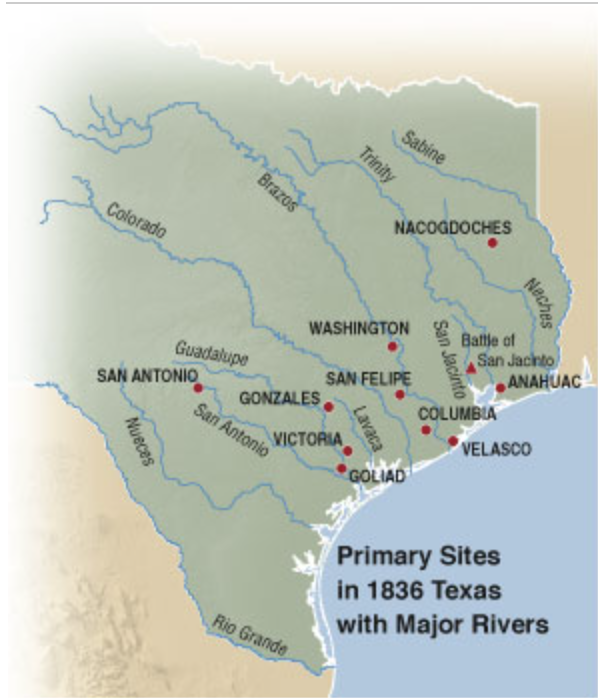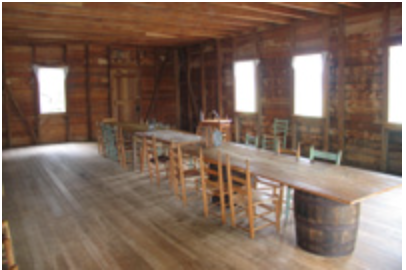1826
Dec. 21 – The Declaration of Independence of the republic of Fredonia is signed at Nacogdoches. This so-called Fredonian Rebellion is an attempt by empresario Haden Edwards to separate his colony from Mexico. The rebels flee when approached by Mexican troops on Jan. 31, 1827.
1829
Sept. 15 – Mexico abolishes slavery. Texas is given an exemption after protests.
October – The first of several large groups of Irish immigrants arrive to settle in South Texas.
1830
April 6 – The Mexican government passes a law stopping legal immigration into Texas from the United States except in special cases, banning further introduction of slaves, and establishing custom houses to collect tariffs. Relations between Anglo settlers and the Mexican government deteriorate.
1831
Johann Friedrich Ernst, his wife and five children are the first German family to arrive in Texas, settling in present-day Austin County. Ernst writes a long letter to a friend in Germany describing Texas as an earthly Eden. The letter is widely circulated, persuading a small but steady stream of German families to migrate to southeastern Texas.
1832
June 10 – Texan insurgents upset with the Law of 1830 occupy buildings at Anahuac. Mexican military fire on the Texans. The conflict results in five Mexican soldiers and one Texan killed.
June 26 – Texans, transporting a cannon from Brazoria to Anahuac, are challenged by Mexican forces at Velasco. The Mexicans surrender after losing five men. The Texans lose 10 men from the battle.
Aug. 2 – Texan insurgents at Nacogdoches attack Mexican military. Mexican forces lose 47 men, while four Texans died from the battle. Some 300 Mexican soldiers are taken prisoner and marched to San Antonio where they are discharged.
Oct. 1-6 – Stephen F. Austin heads a convention at San Felipe de Austin seeking statehood separate from Coahuila and exemptions for Texas of tariffs and certain Mexican laws. The resolutions were never presented to Mexican government.
1833
April 1 – A second convention at San Felipe de Austin reiterates the petitions of the Convention of 1832 and frames a proposed constitution for the new state of Texas.
July – Stephen F. Austin goes to Mexico City to discuss reforms. The trip results in his arrest without any charges. He was held until August 1835 when he returned to Texas.
1834
January – As Mexican authorities fear that Texas was about to secede or revolt, Col. Juan Nepomuceno Almonte is dispatched to Texas to make an accurate inspection and to promise reforms to gain time.
March – Texas is granted more representation in the state government, trial by jury is introduced, and English is authorized as a second language.
April – President Antonio López de Santa Anna suspends the Mexican Constitution of 1824 and assumes dictatorial powers.
1835
June – At Fort Anahuac another dispute results in the arrests of Andrew Briscoe and DeWitt Clinton Harris. In the skirmish over the arrests, another Texan, William Smith, is wounded. William B. Travis then led a force of 25 men to gain the surrender of the 40-man Mexican garrison and the freeing of the two Texans.
Oct. 2 – Mexican troops attempt to retrieve a cannon that had been given to Gonzales colonists for protection from Indian attack. The skirmish that ensues as Gonzales residents dare the Mexicans to "come and take it" is considered the opening battle of the Texas Revolution. Two Mexican soldiers were killed. There were no Texan casualties.
Oct. 10 – Gail Borden begins publishing the newspaper Telegraph and Texas Register at San Felipe de Austin.
Nov. 1 – A "consultation" convenes at San Felipe; on Nov. 7 the delegates agree to establish a provisional government.
Nov. 24 – The Texas Rangers organization is officially established by Texas' provisional government. Although Stephen F. Austin had hired 10 frontiersmen as "rangers" to help protect his colonists against Indian raids in 1823, not until 1835 was the law-enforcement group formally organized.
1836
March 2 – The Texas Declaration of Independence is adopted at Washington-on-the-Brazos.
March 6 – A 13-day siege of the Alamo by Mexican troops led by Santa Anna ends on this day with a battle in which all remaining defenders are killed.
March 10 – Sam Houston abandons Gonzales and retreats eastward to avoid the advancing Mexican army. Panicky settlers in the area flee as well in an exodus called the Runaway Scrape.
March 27 – About 350 Texan prisoners, including their commander James Fannin, are executed at Goliad by order of Santa Anna. An estimated 30 Texans escape.
April 21 – In a battle starting about 4:30 p.m. and lasting 18 minutes, Texan troops led by Sam Houston defeat the Mexican army commanded by Santa Anna at San Jacinto near present-day Houston. Sam Houston reports that 630 Mexican troops were killed and 730 were taken prisoner. Of the Texas troops, nine of a force of 910 were killed or mortally wounded, and 30 were less seriously wounded.
May 14 – Santa Anna and Texas' provisional president David Burnet sign two Treaties of Velasco – one public, the other secret – ending the Texas Revolution. The treaties were, however, violated by both sides. Texas' independence was not recognized by Mexico and Texas' boundary was not determined until the Treaty of Guadalupe Hidalgo, which ended the Mexican War, was signed in 1848.
Sept. 5 – Voters of the new republic choose their first elected officials: Sam Houston becomes president and Lorenzo de Zavala, vice president. The voters also overwhelmingly approve a referendum requesting annexation by the United States. U.S. President Martin Van Buren refuses to consider it, however, citing fear of war with Mexico and constitutional scruples.
October – The first Congress of the Republic of Texas convenes at Columbia. The Constitution of the Republic under which it was elected had been adopted in March at Washington-on-the-Brazos. The constitution stated that slaves would remain the property of their owners, that the Texas Congress could not prohibit the immigration of slaveholders bringing their property, and that slaves could be imported from the United States.
Dec. 27 – Stephen F. Austin, called the "Father of Texas," dies of pneumonia at age 43.
1837
The Republic of Texas is officially recognized by the United States, and later by France, England, the Netherlands and Belgium.
1838
August – Vicente Córdova of Nacogdoches and Mexican loyalists there ally with Cherokees and some blacks to resist the Republic. Córdova flees to Mexico after the rebellious force was defeated near the Guadalupe River in Central Texas.
1839
July – Cherokees ejected from Texas at the Battle of the Neches River in Van Zandt County.
Aug. 1 – The first sale of town lots in the new capital of the Republic, which is named for Stephen F. Austin, is held.
1840
Jan. 17 – Federalists of the northern Mexico states met in Laredo to declare independence from the rest of Mexico. The Republic of the Rio Grande claimed the Nueces and Medina rivers as its northern boundary. By November, the independence movement capitulated to the Centralist Mexican government.
March 19 – Comanches, led by a dozen chiefs, meet with officials of the Texas government to negotiate a peace treaty. Believing the Comanches to have reneged on a promise to release all white prisoners, the Texans take the chiefs prisoner. During the Council House fight that follows, 35 Comanches are killed, as are seven Texans.
Aug. 5 – Near Hallettsville, a large band of Comanches, in retaliation for the Council House Fight, begin killing and looting their way across Central Texas. Texas Rangers and a volunteer army defeat the Comanches on Aug. 11 at Plum Creek near Lockhart.
1841
June 20 – The Santa Fe Expedition, launched without Texas Congressional authorization by President Mirabeau B. Lamar, leaves Central Texas on its way west to establish trade with and solidify Texas' claims to territory in New Mexico. Members of group are taken prisoner by Mexican troops, marched to Mexico City and imprisoned. They are finally released in 1842.
1842
The first seeds of large-scale German immigration to Texas are sown when a German society, the Adelsverein, purchases land for settlements in Central Texas.
September – Mexican Gen. Adrian Woll captures San Antonio, claiming reconquest. Woll withdraws from Texas after the Battle of Salado Creek.
December – Remnant of Texas volunteers that chased Woll's force into Mexico is captured at Mier. After an attempted escape and recapture of 176 men, the 17 who drew black beans were executed.



